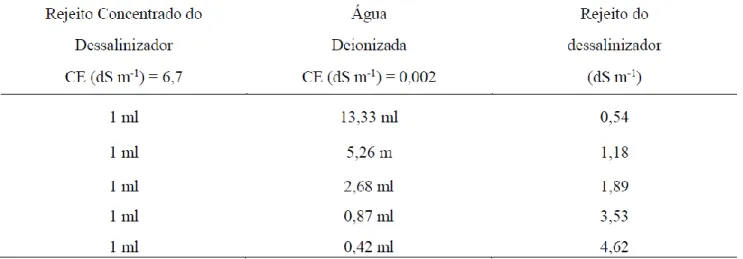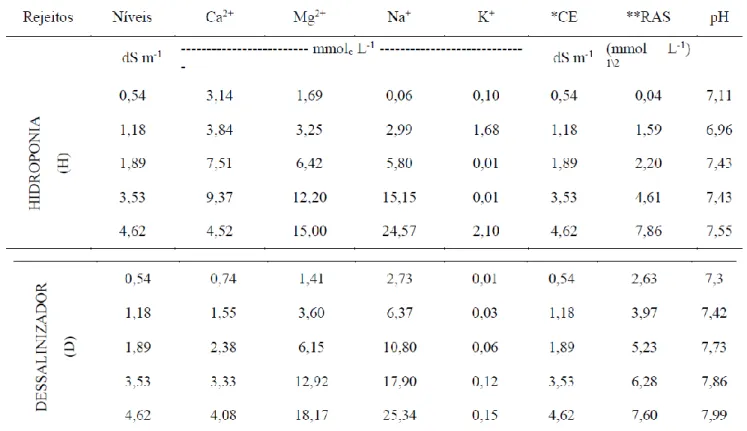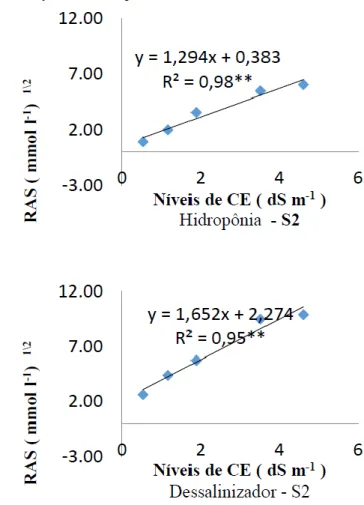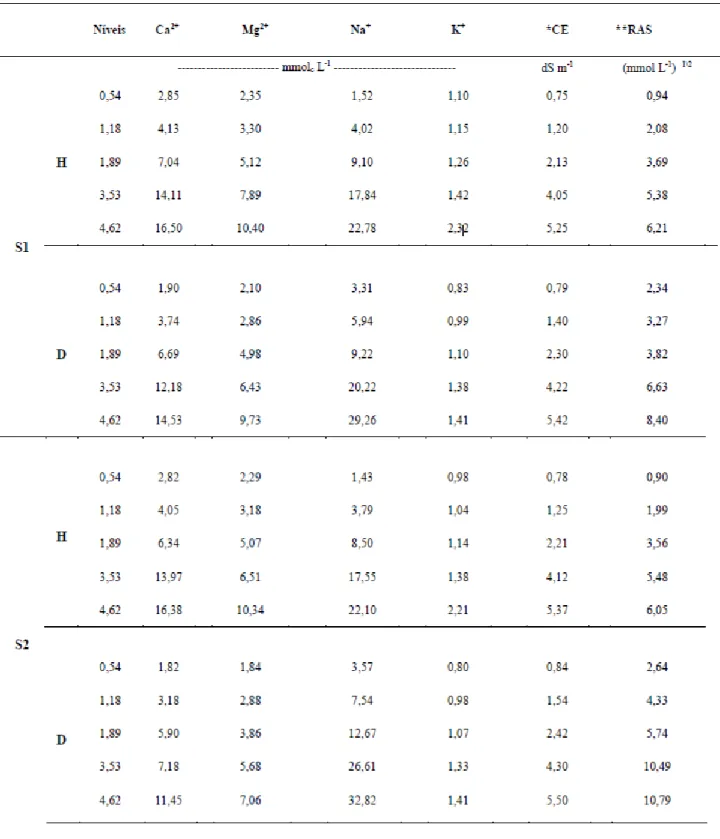Revista Geama
Environmental Sciences
Chemical properties of neossolos flúvicos after application of
irrigation of rejects desalt machine and of hydroponic system
Ricardo Andrade Wanderley
(1)*, Maria de Fátima C. Barros
(2), Fernando Cartaxo Rolim Neto
(1),
Núbia Meirelly Lopes da Silva Epifânio
(2), Cristiane Wanderley
(1).(1)Departamento de Tecnologia Rural, Universidade Federal Rural de Pernambuco, Recife, Pernambuco, Brasil. (2)Departamento de Agronomia, Universidade Federal Rural de Pernambuco, Recife, Pernambuco, Brasil.
Email: ricardo.dtr.ufrpe@gmail.com.
ABSTRACT
Aiming to evaluate the soil salty process of the Ibimirim – PE irrigation project,
submitted to the application of the rejects from desalt machine and from hydroponic
solution, also primarily originated from desalt machine reject, it was realized an
experiment in soil columns, installed in the Soil Mechanic and Residue Use Laboratory
of the Universidade Federal Rural de Pernambuco. The treatments were delineated in
a randomized blocks with factorial arrangement of two soils (claily and sandy), two
types of reject (reject of desalt machine and reject of the hydroponic system) and five
salty concentrations (0.53; 1.16; 1.90; 3.52; 4.60 dS m-1), with three replicates. The
evaluated variables in the extract of the saturated paste were the electric conductivity
(EC) and the relationship of sodium adsorption relationship (SAR). The use of the
leaching depths equivalent to three volumes of pores, using rejects both of desalt
machine and of hydroponic system didn't provide the neither salty process nor sodium
process of the soils studied (EC > 4,00 dS m-1 and SAR < 13(mmol L-1) ½).
Keywords: Salinization, environment and desalination.
INTRODUCTION
Salt affected soils contain soluble salts and / or exchangeable sodium sufficient to reduce or interfere with plant development and consequently crop production quantity. This being one of the limitations of global agricultural production,
especially in irrigated areas located in arid and semi - arid (MELO et al, 2008; BARROS 2012)
In the state of Pernambuco , in the Hinterland of Moxotó region , the main source of drinking water are shallow wells with low cost of production , but the water has relatively high concentrations of salts . This saline water is much exploited in the rural municipality of Ibimirim for human consumption
after being desalted using equipment that remove excess salts from the water, dividing it into drinking water and waste.
Worldwide, growing plants through hydroponics system as an alternative to the use of brackish water is already being used in research long ago, however, in Brazil, only recently came to commercial use.
Advantages as production in small areas, rational use of water and fertilizers, reducing related to cultural over the cycle, early harvest and drastic reduction of pesticides treatment operations, are among the factors that contributed to its diffusion. On the other hand, the high initial investment and the need for specialized training are the points that hinder the adoption of hydroponics as productive practice (FURLANI, 1999; RODRIGUES, 2002) , especially for small farmers .
Mathias (2008), reports that in NFT hydroponics (Technical laminar flow of nutrients ) is already well established among the hidroponistas Brazil . And this type of cultivation has two main advantages for cultivation using brackish water, which is not having direct contact with the environment and the efficient use of water.
On the other hand, the desalination process produces both good water quality and at the same rate, otherwise known as reject water, also known as concentrate or brine, which has a salt concentration approximately doubled in relation to the water originally captured the well, which makes her much more restrictive use. Thus , desalination of brackish water becomes a " double edged sword " , ie , solve a problem and creates another. Improper disposal of waste can cause environmental impacts such as soil salinization and increasing salt concentrations in surface water bodies (SANTOS, 2009).
This study aimed to evaluate the effect of different concentrations of tailings and tailings desssalinizador dessalinazador after being used in growing hydroponically on chemical composition and increased electrical conductivity (EC) and the ratio of adsorption sodium (RAS) of the saturation extract soil .
MATERIALS AND METHODS
For this study two samples (S1 and S2) Entisol soil were collected at a depth of 0-40 cm, the Irrigated Perimeter of Ibimirim - PE. The experiment was conducted at the Laboratory of Soil Mechanics and Utilization of Waste Federal Rural University of Pernambuco . For the collection of soil samples, the procedure described by Magalhães (1987), modified by Barros (2001) was used . A representative sample of soil was obtained for each blend composed of 20 samples, each of which consisted of five sub-samples collected through borehole (auger pitcher) .
The soil characterization was performed on dried samples in air destorroadas and sieved with 2 mm aperture mesh, retreating before this procedure, clods , to obtain density. The saturation extract was obtained using a method described by Richards (1954), were determined in saturated paste extract, electrical conductivity (EC) , pH, calcium and magnesium , the latter two by atomic absorption spectrophotometry , sodium and potassium by flame photometry . With the values for calcium, magnesium and soluble sodium quantify the values for the adsorption ratio Sodium (RAS) using SAR = Na + / [ (Ca + ² + Mg ⁺ ² ) / 2 ] ½ expression. The results are shown in Table 1.
In physical characterization , following the procedure of EMBRAPA (1997) , were determined the hydraulic conductivity by the method described
for soils deformed structure , the particle size distribution after washing with 60% ethanol until complete elimination of chloride, the density of the particles volumetric flask and method of soil density through the clod paraffin (Table 2) method.
Still applying the methodology suggested by Richards (1954), were determined: pH of soil in the soil-water ratio (1:2.5) , the cation exchange capacity (CEC ) by the sodium acetate method. After extraction, sodium and potassium were determined by flame photometry and calcium and magnesium by atomic absorption spectrophotometry. The exchangeable sodium percentage (ESP) was obtained from the data of the CEC and the exchangeable sodium by PST = ( Na + / CTC ) x 100 ( Table 3 ) equation.
The treatments were arranged in a randomized block design with a factorial arrangement of two types of soils ( clayey and sandy) , two types of waste ( tailings and waste water maker of hydroponics) and five salt concentrations ( 0.54 , 1.18 ; 1.89 , 3.53 , 4.62 dS m - 1 ) with three replications .
The water from the desalinator has a tubular shaft equipped with a reverse osmosis device, capable of producing 1200 h -1 L of demineralized water and waste. The attainment of the five levels of salinity hydroponic reject (0.54 , 1.19 , 2.2, 3.53 and 4.62 dS m - 1 ) used in this study followed the methodology described by Santos (2009 ).
In the desalination reject the same levels of electrical conductivity of the tailings were used hydroponics. Salinity levels in the tailings were obtained using as source saline well water desalination and waste thereof. To achieve higher levels of salinity, the waste was again desalted desalination system (" bypass ") , thereby producing even more saline waste with an electrical
conductivity of approximately 6.70 dS m- 1. For the final adjustment so that the electrical conductivity (EC) Reject the desalter reached the same levels of concentrations of hydroponic reject, deionized water was added. The mixing ratio, deionized water + waste of the desalination unit is in Table 4
.
The composition of the waste hydroponics and water desalination is described in Table 5.The experimental units were comprised of plastic tubing, PVC , 10 cm diameter and 40 cm in height, having a closed with the PVC cover , the center of which a spigot end is adapted from 3/ 8 inch (Figure 1 and 2) . At the end of the column, open meshes were placed sequenced in order to simulate a gradient of drainage. Soil samples were packed in columns to approach the bulk density of each sample.
After the soil columns were slowly wetted with the waste until they reach saturation by capillarity , remaining in this humidity for 24 h , to restore balance to the system . Then the soil columns were leached with waste, maintaining a constant level of solution 2 cm above the soil surface. In leaching, we used an equivalent blade to three times the pore volume (2.100 mL). After leaching , the columns were separated and air-dried soils, destorroados and passed through a sieve of 2 mm aperture ; were determined in saturated paste extract , electrical conductivity ( EC ) , soluble cations , the adsorption ratio Sodium (RAS) .
The data of the electrical conductivity (EC), the Sodium Adsorption Ratio ( SAR) were interpreted by analysis of variance and regression , testing various models . The criteria for choosing the model was the highest value of the adjusted coefficient of determination and significance of the coefficients of the regression equation, using the Statistical Analysis System (SAS , 1992) statistical program.
Tabela 1 – Composição do extrato da pasta saturada dos solos.
Tabela 2 - Características físicas das amostras de solo.
Tabela 3 - Características químicas das amostras de solos
Tabela 4 – Proporção da mistura (água deonizada + rejeito do dessalinizador) para obtenção dos cincos níveis de salinidade dos rejeitos do dessalinizador
Tabela 5 - Composição química dos rejeitos.
Figura 2 – Relação entre os níveis de CE e RAS no rejeito de hidroponia e dessalinizador (S2).
RESULTS AND DISCUSSION
After application of the water depth was verified results for the composition of the saturation extract of soils is shown in Table 6, it is observed that for the treatments they received as a source of water for leaching the tailings hydroponics , the values found for soluble sodium in the first level of electrical conductivity ( 0.54 dS m - 1 ) , shows an opposite to those observed for calcium, magnesium and soluble potassium trend. Experiencing a decrease in the amounts of soluble sodium and calcium, magnesium and potassium there is increased compared conditions prior to treatment application.
This behavior is observed for both soils under study. This is possibly due to the smaller amount of sodium found in the waste treatments of hydroponic
as the sodium was added via fertilizers in very small quantities, such as sodium molybdate ( 0,15 g m -3). In this treatment prevailed concentration of hydroponic solution, which was much more concentrated in calcium and magnesium. As a source of calcium having calcium nitrate ( 750g m -3) , magnesium magnesium sulfate ( 400g m -3) and potassium nitrate ( 182.5 g m -3), resulting in higher concentrations of calcium, soluble magnesium and potassium over the soluble sodium.
The values obtained for soluble sodium show the opposite, for the first and second levels of EC , with the highest values found in the treatment with the waste of the desalter . In general , from the application of the third level of salt concentration, the content of soluble sodium are higher than those found for calcium. These results are explained by the
greater amount of sodium present in the waste of desalination, especially in higher levels of EC used. It is also noted that from the application of the fourth level of EC (3.53 dS m - 1 ) , the values for soluble sodium present themselves higher than those found for calcium, magnesium and soluble potassium, regardless of tailings used . This stems from the higher concentration of sodium present in both the tailings hydroponics as in the desalination reject these levels . This result is evidenced by the higher concentration of sodium in relation to soluble calcium found in the last two levels of salinity EC = 3.53 dS m -1 and 4.62 dS m -1 (Table 6).
These results are consistent to those cited by Amorim et al. (2004) , who warn that the tailings of desalination plants have the potential to contaminate soil , water sources and even the flora and fauna of the region . These authors also observed a predominant sodium salt (NaCl) and concluded that the presence of high concentration of soluble sodium may replace calcium in the cation exchange sites , causing the dispersion of clay soil , contributing to reducing its hydraulic conductivity thereof.
The soluble potassium values showed little differentiation between treatments for both irrigated condition with tailings hydroponics as to when irrigated with desalinator , showing a small increase in the soils where the tailing hydroponics was used . This increase is probably due to the use of potassium fertilizer in hydroponics. The increase in potassium
irrigation condition in the waste of desalination can be explained by the ability of the soil to supply potassium to maintain the initial balance between soluble and exchangeable as soils that region, and second Barros and Moura (2003), have mica and feldspar in its constitution.
The data obtained for SAR and EC after treatment application indicate proportional increase in these two variables with levels of salt concentrations used for the soils under study.
You can also see a trend towards salinization of soils and for the last two levels of EC apllicados occurred salinisation ( EC > 4.00 dS m - 1 ) was used when both reject the desalter as waste hydroponics . It is noteworthy that the threshold for separation of saline soil and non- saline value is according Richards (1954) is 4.00 dS m - 1. However, many cultures have reduced their production long before that value. Alencar et al. ( 2003) found that the threshold value from salinity ( EC = 2.2 dS m - 1 ) , the one-unit increase of soil salinity can result in a decrease of 6.86 % of the dry matter of shoots of melon to cultivars Gold Mine and AF -646 cultured up to 39 days after sowing . Similar results are reported by Gomes et al . (2000) , who reported for rice cultivation an EC threshold of 3.3 dS m - 1 . For the RAS, we observe the same trend, however, without risk of sodification a soil is considered sodic when presenting a RAS > 13 ( mmol L- 1 ) ½ , with criteria described by McNeal (1976 ) .
Tabela 6 - Composição do extrato da pasta saturada dos solos depois da aplicação dos rejeitos.
REFERENCES
MCNEAL, B. L. Managing salt-affected soil. Crops and Soils Magazine, Madison, v. 12, p.12-13, 1976.
AMORIM, M.C.C.; PORTO, E.R.; SILVA JÚNIOR, L.G.A. Evaporação solar como alternativa de reuso dos efluentes da dessalinização por osmose inversa. http://www.cepis.org.pe/bvsaidis/aresidua/i-007.pdf. 10 Jul. 2004.
BARROS, M.de F.C. Recuperação de solos salino-sódico pelo uso de gesso de jazida e calcário. 2001. 118p. Tese (Doutorado) – UFV, Viçosa, Minas Gerais, 2001.
BARROS, M.de F.C.; MOURA, R.F. Mineralogia de dois Neossolos Flúvicos do estado de Pernambuco. In: SIMPÓS da UFRPE, 4, 2003, Recife, PE. Anais..., Recife, PRPPG/UFRPE, 2003, CD Room.
BARROS, M. de F.C. Manejo de solos degradados pela salinização e sodificação. In: Fertbio 2012, Maceió - AL, 2012, Anais... Maceió, SBCS, 2012, CD Room.
EMBRAPA – Empresa Brasileira de Pesquisa Agropecuária. Manual de método de análises de solo. 2° Ed. Rio de Janeiro: EMBRAPA. 1997, 212p.
FURLANI, P. R.; SILVEIRA, L. C. P.; BOLONHEZI, D.; FAQUIN, V. Cultivo hidropônico de plantas. 1.ed. Campinas: IAC, 1999. 52p. Boletim técnico, 180.
MAGALHÃES, A. F. Métodos de análise químicas para solos salinos e sódicos. Recife, DEPA/UFRPE, 1987. 30p. MATHIAS, M. NFT in Brazil. Practical Hydroponics & Greenhouses. Narrabeen, p.33-40, 2008.
MELO, R.M.; BARROS, M.de F.C.; SANTOS, P.M.; ROLIM, M.M. Correção de solos salino-sódico pela aplicação de gesso mineral. Revista Brasileira de Engenharia Agrícola e Ambiental, Campina Grande, v.12, p. 376-380, 2008.
RICHARDS, L. A. Diagnosis and improvement of saline and alkali soils. U. S. Dep. Agric. Handbook 60 Washington,. U. S. Gover nment Printing, Office, D. C., 1954. 160p.
RODRIGUES, L.R.F. Técnicas de cultivo hidropônico e de controle ambiental no manejo de pragas, doenças e nutrição vegetal em ambiente protegido. 1.ed. Jaboticabal: FUNEP, 2002. 762p.
SANTOS, A.N. Rendimento e avaliação nutricional do cultivo hidropônico de alface (Lactuca sativa L.) em
sistema NFT no semiárido brasileiro utilizando águas salobras. 2009. 133p. Dissertação (Mestrado) – UFRPE, Recife, 2009.
SAS – Statistical analysis system. Release 6.08, (software). Cary: SAS Institute, 1992. 620 p.



